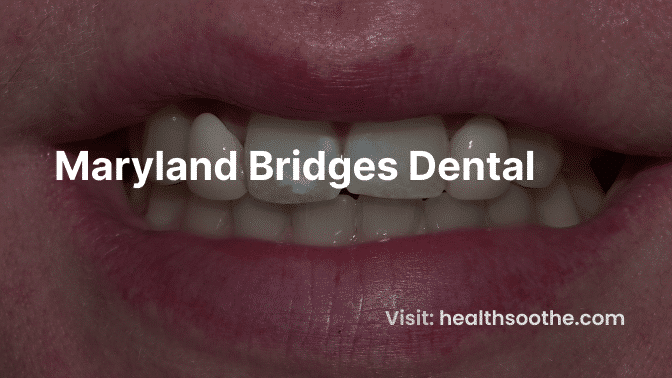Losing a tooth can be a distressing experience, impacting not only your oral health but also your confidence. Thankfully, advancements in dental technology have provided various options for tooth replacement, including Maryland bridges.
In this blog post, we will delve into the world of Maryland bridges, exploring what they are, their benefits, candidacy, the procedure involved, maintenance, potential risks, and cost.
By the end, you'll have a thorough understanding of Maryland bridges and whether they are the right dental solution for you.
What are Maryland Bridges?
Maryland bridges, also known as resin-bonded bridges or Maryland-bonded bridges, are a type of dental bridge used to replace missing teeth.
Unlike traditional bridges that require the support of adjacent teeth with dental crowns, Maryland bridges rely on a framework of metal or ceramic wings bonded to the back surfaces of adjacent teeth.
These wings provide stability and support for the replacement tooth, known as a pontic, which fills the gap left by the missing tooth.
Benefits of Maryland Bridges:
Maryland bridges offer several benefits as a tooth replacement option. Let's explore some of the advantages of choosing Maryland bridges:
- Conservative Approach: One of the significant benefits of Maryland bridges is their conservative nature. Unlike traditional bridges that require the preparation and crowning of adjacent teeth, Maryland bridges involve minimal alteration of the adjacent teeth. This conservative approach helps preserve the natural tooth structure and reduces the potential risks associated with extensive tooth preparation.
- Aesthetically Pleasing: Maryland bridges provide a natural-looking and aesthetically pleasing result. The metal or ceramic wings that support the pontic are bonded to the back surfaces of adjacent teeth, creating a seamless appearance. The wings can be custom-coloured to match the shade of your natural teeth, ensuring that the bridge blends in harmoniously with your smile.
- Quick and Non-Invasive Procedure: Getting Maryland bridges typically involves a relatively quick and non-invasive procedure. The tooth preparation required for Maryland bridges is minimal compared to traditional bridges. As a result, the process is generally less time-consuming and more comfortable for the patient.
- Comfortable Fit: Maryland bridges are designed to fit securely and comfortably in the mouth. The bridge is custom-made based on impressions of your teeth, ensuring a precise and tailored fit. With proper placement and adjustments, the bridge should feel comfortable and natural, allowing you to speak, eat, and smile with confidence.
- Cost-Effective Option: Compared to other tooth replacement options like dental implants, Maryland bridges are generally a more cost-effective solution. While the cost can vary depending on factors such as the number of missing teeth and the materials used, Maryland bridges tend to be more affordable and accessible for many patients.
Comparison with Other Dental Bridge Options:
While Maryland bridges have their advantages, it's essential to compare them with other dental bridge options to make an informed decision.
Traditional bridges, implant-supported bridges, and cantilever bridges each have their unique features and suitability for specific cases. Understanding these differences can help you determine which option best fits your needs.
Read Also: "How is a Maryland Bridge held in place"
Candidates for Maryland Bridges:
Not everyone is an ideal candidate for Maryland Bridges. Factors such as the condition of adjacent teeth, the location of the missing tooth, and overall oral health play a role in determining candidacy. Your dentist will evaluate these factors and conduct a thorough examination to determine whether Maryland bridges are a suitable option for you.
Procedure for Getting Maryland Bridges:
- Initial Consultation: Your dentist will examine your oral health, discuss your goals and expectations, and determine if Maryland Bridges are the right choice for you.
- Tooth Preparation: If deemed suitable, the adjacent teeth will be minimally prepared to accommodate the metal or ceramic wings. Impressions of your teeth will be taken to create a custom-made bridge.
- Temporary Bridge: While your permanent bridge is being fabricated in a dental laboratory, a temporary bridge will be placed to protect your teeth and gums.
- Bridge Placement: Once the permanent bridge is ready, your dentist will remove the temporary bridge and bond the Maryland bridge onto the prepared teeth. Adjustments will be made to ensure a comfortable and precise fit.
Maintenance and Care of Maryland Bridges:
Proper maintenance and care are essential to ensure the longevity of your Maryland bridges. Follow these tips:
- Brush your teeth twice a day with a soft-bristled toothbrush and non-abrasive toothpaste.
- Floss daily, using floss threaders or interdental brushes to clean around the bridge and under the pontic.
- Avoid biting into hard or sticky foods that could damage the bridge.
- Schedule regular dental check-ups to monitor the condition of your bridge and overall oral health.
Potential Risks and Complications:
While Maryland bridges are generally a safe and effective tooth replacement option, there are potential risks and complications to be aware of.
These may include sensitivity, chipping or dislodging of the bridge, and gum or tooth decay if proper oral hygiene is not maintained. Your dentist will provide you with guidance on how to mitigate these risks.
Cost of Maryland Bridges:
The cost of Maryland bridges can vary depending on factors such as the number of missing teeth, materials used, and geographical location.
It's advisable to consult with your dentist and inquire about the cost specifics, including any potential insurance coverage or financing options available to you.
Conclusion
Maryland Bridges offer a conservative and aesthetically pleasing solution for tooth replacement. By understanding the procedure, benefits, maintenance, and potential risks associated with Maryland bridges, you can make an informed decision in consultation with your dentist.
Remember, each case is unique, so it's crucial to seek professional advice to determine whether Maryland Bridges are the right dental option for you. Restore your smile and regain your confidence with the help of Maryland Bridges.
Q1: What is a Maryland bridge in dental terms?
A1: A Maryland bridge, also known as a resin-bonded bridge or a Maryland adhesive bridge, is a type of dental bridge used to replace a missing tooth. It consists of a prosthetic tooth (pontic) that is attached to metal or porcelain wings on each side. These wings are bonded to the back of the adjacent natural teeth, providing support and anchorage for the bridge.
Q2: How is a Maryland bridge different from traditional dental bridges?
A2: A Maryland bridge differs from traditional dental bridges in the way it is attached to the adjacent teeth. Unlike traditional bridges that require the adjacent teeth to be reshaped and crowned, a Maryland bridge utilizes wings or "adhesive wings" that are bonded to the back of the adjacent teeth, eliminating the need for extensive tooth preparation.
Q3: What are the advantages of Maryland bridges?
A3: Some advantages of Maryland bridges include: Minimal tooth preparation: Maryland bridges require minimal tooth preparation, preserving the structure of the adjacent teeth. Conservative approach: Since Maryland bridges do not involve extensive tooth preparation, they offer a more conservative treatment option. Aesthetics: The metal or porcelain wings used in Maryland bridges are designed to match the color of the natural teeth, resulting in a more aesthetically pleasing restoration. Quick and reversible: Maryland bridges can be placed relatively quickly and are reversible, making them a suitable option for certain cases.
Q4: Are there any limitations or drawbacks to Maryland bridges?
A4: Maryland bridges have some limitations, including: Strength: Compared to traditional bridges, Maryland bridges may not be as strong or durable, especially in cases where there is significant biting force or heavy chewing. Suitable for specific cases: Maryland bridges are generally recommended for replacing front teeth or areas with less biting force. They may not be suitable for replacing molars or teeth subjected to significant chewing forces. Potential for debonding: The adhesive bond between the wings and the adjacent teeth may weaken over time, resulting in the bridge becoming loose or dislodged. Proper oral hygiene practices and avoiding biting on hard or sticky foods can help minimize this risk.
Q5: How long does a Maryland bridge typically last?
A5: The lifespan of a Maryland bridge can vary depending on several factors, including oral hygiene practices, biting forces, and the quality of the restoration. With proper care and regular dental check-ups, a well-maintained Maryland bridge can last for several years. However, it's important to note that they may require periodic monitoring and potential replacement over time due to wear or debonding. Your dentist can provide guidance on the specific longevity of your Maryland bridge based on your individual circumstances.




